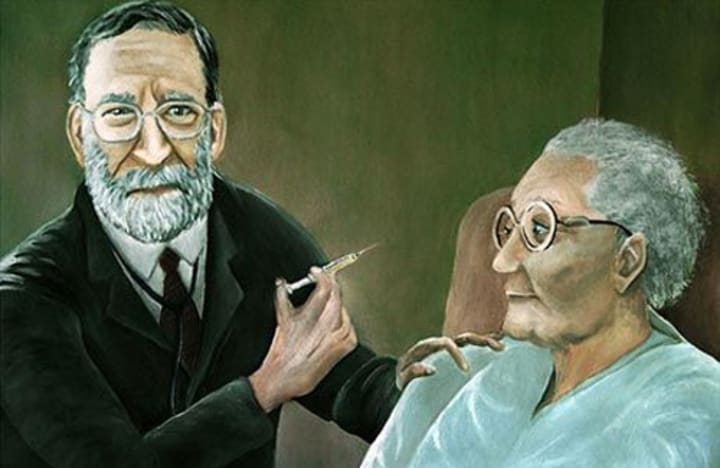Killing His Patients For Pleasure
Nobody was aware that the "good doctor" was killing his victims secretly - more than 250 people were murdered.

Doctors are meant to assist patients during their most vulnerable times. Dr. Harold Shipman, however, did more than only abuse his power over his patients; he also rose to become one of the most active serial killers in English history.
Shipman would give his patients false diagnoses for ailments they didn't have before administering a fatal dosage of diamorphine. The 250 people who allegedly perished at his hands between 1975 and 1998 were unaware that their visit to Harold Shipman's office would be their last act.
How Harold Shipman Became a Doctor and a Murderer

In 1946, Harold Shipman was born in Nottingham, England. He had a bright academic future and was a standout in athletics, notably rugby.
But when Shipman was barely 17 years old, the direction of his life shifted. His mother Vera, with whom Shipman had a strong relationship, received a lung cancer diagnosis that year. Shipman watched intently as the doctor gave her morphine as she lay dying in the hospital, relieving her pain.
Later, experts would surmise that this was the trigger for his cruel killing spree and method of operation.
Shipman married Primrose May Oxtoby when his mother passed away, and they were both attending Leeds University Medical School at the time. When viewed from the outside, Shipman's life was the image of normalcy. The couple had four children together.
He started out as a junior doctor after graduating in 1970, but he swiftly rose through the ranks and was hired by a medical facility in West Yorkshire as a general practitioner.
In 1976, Shipman ran into legal issues for the first time in this location. The young physician was discovered writing himself fake Demerol prescriptions, an opioid that is frequently used to treat severe pain. Shipman was dependent on drugs. He received a fine, lost his job, and had to go to a recovery center in York.
In 1977, Harold Shipman appeared to bounce back fast and went back to work at the Donneybrook Medical Center in Hyde. He would work here for the following 15 years of his career before starting a solo practice in 1993. He earned a reputation as a kind and competent doctor among his patients and in his neighborhood. His bedside demeanor was well-known.
But nobody was aware that the "good doctor" was also killing his victims in silence.
The Crimes of the Doctor

Shipman saw 70-year-old Eva Lyons as his first patient in March 1975. Her birthday was the next day.
Although no one even knew Shipman had an addiction until the next year, he had acquired enough diamorphine at this point to murder hundreds of people.
Shipman was dismissed that year for falsifying prescriptions, but the General Medical Council, which oversees doctors, did not expel him. He was instead sent a letter of caution.
Over the course of his decades-long reign of terror, Shipman allegedly stopped and started his murdering spree several times. However, he always used the same murdering technique. His victims would be weak people; the oldest was Anne Cooper, 93, and the youngest was Peter Lewis, 41.
He would then give them a fatal dosage of diamorphine and either leave them to die there or send them home to die.
He is thought to have murdered a total of 71 patients while working at the Donneybrook clinic and the remaining victims while running his own business. 44 men and 171 women were among his victims.
However, in 1998, the quantity of Shipman's patients who were passing away raised suspicions among the local funeral directors in Hyde. The nearby medical facility also learned that his patient's death rate was over ten times greater than theirs.
The Greater Manchester Police were then contacted after they expressed their concerns to the local coroner. This may have signaled the end of Shipman's horror, but it didn't.
The police inquiry lacked the most fundamental inspections, such as a background check on Shipman. He had previously falsified prescriptions, which they would have discovered if they had inquired about what was in his file with the medical board.
Additionally, cunning Shipman hid his tracks by documenting fictitious diseases for his victims. Because there was nothing suspicious discovered throughout the inquiry, the murderous doctor was free to continue his murdering spree.
The Startling Murder That Eventually Made Dr. Harold Shipman Public

When Shipman made the error of attempting to fake the will of Kathleen Grundy, an 81-year-old former mayor of his town of Hyde, one of his victims, his misdeeds were ultimately discovered.
Grundy received a fatal dosage of diamorphine from Shipman, who then checked the "cremation" box on her will to conceal the evidence. The will was then modified by him using his typewriter to completely exclude her relatives and leave everything to himself.
In spite of this, Grundy was buried, and local attorneys informed her daughter, Angela Woodruff, about the will. She called the police as soon as she suspected foul play.
Regarding the circumstance, Woodruff remarked, "The whole thing seemed unimaginable that my mother would sign the paperwork designating her doctor as my caretaker. It didn't make sense for her to sign a paper that was so poorly worded."
Following the exhumation of Grundy's remains in August 1998, diamorphine was discovered in her muscular tissues. On September 7 of that year, Shipman was then taken into custody.
11 more victims' remains were unearthed over the course of the following two months. A police specialist also looked at Shipman's medical office computer and found that he had produced bogus entries to support the fabricated causes of death he claimed on the death certificates of his victims.
At the same time, Shipman argued, using his notes as proof, that Grundy was dependent on a substance like morphine or heroin. Police, however, discovered that Shipman had created the notes on his computer following her passing.
Then, authorities were able to confirm 14 more incidents in which Shipman had administered deadly amounts of diamorphine, fraudulently documented the patients' deaths, and manipulated with their medical records to make it appear like they were dying anyhow.
Harold Shipman constantly denied the killings and refused to collaborate with cops or criminal psychiatric experts. When the police attempted to interrogate him or show him photographs of his victims, he sat with his eyes closed, yawned, and refused to look at any evidence.
Police could only prosecute Shipman with 15 killings, but it's estimated that he killed between 250 and 450 people.
Suicide in Jail

Shipman was sentenced to life in prison in 2000, with the recommendation that he never be freed. He was imprisoned in Manchester then transferred to Wakefield Prison in West Yorkshire, where he committed suicide. Shipman was discovered hanging in his cell on Jan. 13, 2004, the day before his 58th birthday.
He had previously informed his probation officer that he was considering suicide in order for his wife to collect his pension and lump payment.
The mystery of why he killed hovers over his death. A lot of explanations have been proposed to explain why Shipman felt the need to kill; some believe he was vengeful for his mother's death.
Others believe he injected diamorphine into the elderly as a mistaken act of sympathy.
Others believe the doctor had a God Complex and simply wanted to demonstrate that he could take as well as preserve life.
So, what do you think of this man - Harold Shipman? Please, share your thoughts in the comments!
Thank you for taking the time to read my new Story! I appreciate you :)
About the Creator
Victoria Velkova
With a passion for words and a love of storytelling.






Comments
There are no comments for this story
Be the first to respond and start the conversation.